Bookshelf Speakers are one of my favorite ways to meet, home theater system requirements. They can provide excellent sound quality without taking valuable or interfering with the decor.
 Which are used for the main room, or in a family room, bedroom, or study, or if they are used to provide rear audio in a home theater system or general purpose, multi-room set-up, built-in shelf speakers can play a key role in creating audio quality, in my experience?
Which are used for the main room, or in a family room, bedroom, or study, or if they are used to provide rear audio in a home theater system or general purpose, multi-room set-up, built-in shelf speakers can play a key role in creating audio quality, in my experience?
The technological advances that have been made in recent years to get the volume of sound fidelity and compact speakers are really remarkable. Just do not need anything bigger, and you can always add a subwoofer if you decide that you need to whisper, to provide new momentum at lower frequencies.
What are Best Bookshelf Speakers
Table of Contents
There is a wide variety of Best Bookshelf Speakers under 1000 dollars, And it’s not just a question of whether one is more affordable than another or by manufacturers. Each brand has opted for several plus -such as design, quality of self-powered and even three-way to show the evolution of their models.
The most important thing to keep in mind before buying a great Book Shelf speaker is to know its impedance and compare it with the stereo to which you will connect it.
In addition, it is essential that you look at the power of these speakers and if they would not overload when connected to home theater equipment.
It is a fact that for its endowments, you would require a little more pasta for a Bookshelf speaker than for a standard one; However, here we have prepared a Comparison Table of the Best Bookshelf Speakers Under $1000, among which you could buy according to your need and requirements.
Keep Reading…
We have a Buyer’s Guide Section to assist you to take the best buying decision.
Best Bookshelf Speakers Under 1000$ in 2025 | Comparison Table
Top Picks | 5-Starts Rating | High Quality
| SoundBars | Impedance (ohms) | Weight (Ibs) | Price $$ |
|---|---|---|---|
| ELAC B6.2 Debut 2.0 | 6Ω | 16.3 | |
| SVS Ultra (Editor's Choice) | 8Ω | 19 | |
| Definitive Technology Demand Series D9 | 8Ω | 15 | |
| Audioengine HD6 | 37.9 | ||
| Klipsch The Sixes Powered Monitor | 17.7 | ||
| Q Acoustics 3020i | 6Ω | 12.1 | |
| Fluance Signature Series HiFi | 8Ω | 9.7 | |
| Kanto YU6 | 9.4 | ||
| Wharfedale - Diamond 220 Best Budgeted | 4Ω | 11.7 | |
| MartinLogan Motion 4i | 4Ω | 10 |
Best Bookshelf Speakers Under $1000 in 2025 | Products Overview
1.ELAC B6.2 Debut 2.0 Good Value For Money
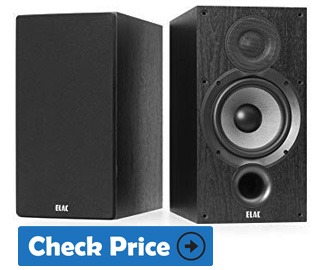 The ELAC B6.2 was designed by audio engineer Andrew Jones. Having pioneered loudspeaker technology in four different companies, Jones accumulates a wealth of knowledge on how to design truly capable loudspeakers. As expected, his experience produced another product of the considered, venerable.
The ELAC B6.2 was designed by audio engineer Andrew Jones. Having pioneered loudspeaker technology in four different companies, Jones accumulates a wealth of knowledge on how to design truly capable loudspeakers. As expected, his experience produced another product of the considered, venerable.
While they are not particularly innovative in terms of aesthetics, the B6 look good. The loudspeaker has a design characterized by its black coloration. A detachable fabric grid with a similar hue is also included in the set.
Intelligently, the bolts that connect the loudspeaker to the loudspeaker rest on the loudspeaker instead of on the louver.
The main technical innovation brought by this new range is at the level of the new tweeter with ” wide dispersion waveguide “, which should limit the directivity of highs, and thus improve spatialization.
A bass port occupies the back of the B6, along with a collection of 5-way gold ports that offer connectivity to numerous devices.
And in terms of its dimensions, the B6 is 35.5 cm. high, 21.6 cm. wide and 25.4 cm. of depth and a speaker weighs about 16.31Ibs.
Specifications
| Amplifier Wattage | 30W-120W per channel |
| Impedance | 6Ω |
| Driver Sizes | 6.5″ Midrange, 1″ Tweeter |
| Sensitivity | 87dB |
- Wide roll surround sound
- Great sound with an affordable price
- An extremely linear bass
- Very nice amplification and low distortion
2.SVS Ultra: Best Bookshelf Speaker Under $1000 (Editor’s Choice)
Pair of bookshelf speakers
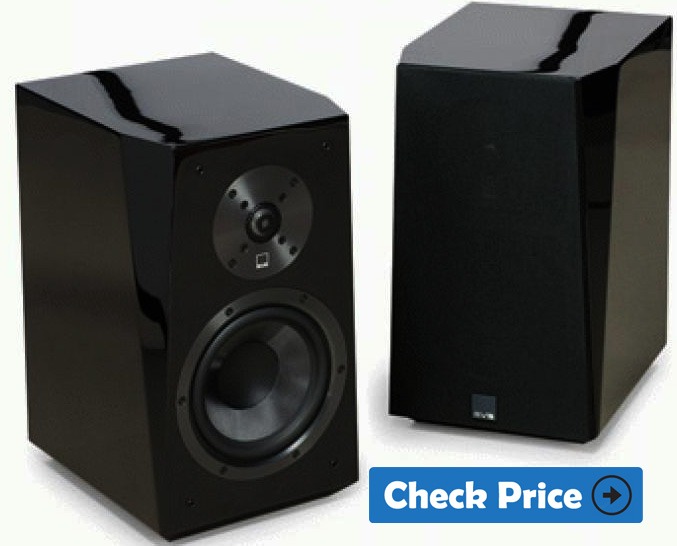 The Ultra Bookshelf is a unique library speaker. A speaker capable of delivering a broadband sound effortlessly and a soundstage whose incredible spatialization and dynamics are enough to annoy many competitors!
The Ultra Bookshelf is a unique library speaker. A speaker capable of delivering a broadband sound effortlessly and a soundstage whose incredible spatialization and dynamics are enough to annoy many competitors!
It is one of the best bookshelf speakers all the time.
A real jewel... Incorporating remarkably advanced technologies, the Ultra Bookshelf draws its technological and aesthetic inspiration from the sculptural Ultra Tower. Available in the real black oak finish or black piano lacquer, the Ultra Bookshelf will integrate and enhance any interior.
The SVS Ultra Bookshelf delivers sharp, chiseled highs with its aluminum dome tweeter, a 16.5 cm midrange/woofer for vocals and vocals striking with clarity and fluidity, and deep bass and stretched with the cord. Farewell to speakers who are always missing something, say hello to the "real" sound made in the USA.
It provides unparalleled sound quality and flexibility with 2-way bass-reflex.
Filters & High-Quality HP E
Filter exclusive SoundMatch, aluminum dome tweeter with an optimized diffuser to eliminate artifacts, woofer motor designed by computer, shorting ring to reduce distortion, cone treated to minimize resonances. Everything was set to make Ultra the new reference in their category.
New Exclusive Filter
From the development of the Ultra series, the Prime benefits from a brand new filter ensuring a flat and homogeneous response over the entire frequency band.
Specifications
| Amplifier Wattage | 20W-150W per channel |
| Impedance | 8Ω |
| Driver Sizes | 6.5" Midrange, 1" Tweeter |
| Sensitivity | 87dB |
- The most advanced components and technologies
- Excellent rigidity and absence of resonance
- Full and taut bass
3. Definitive Technology Demand Series D9
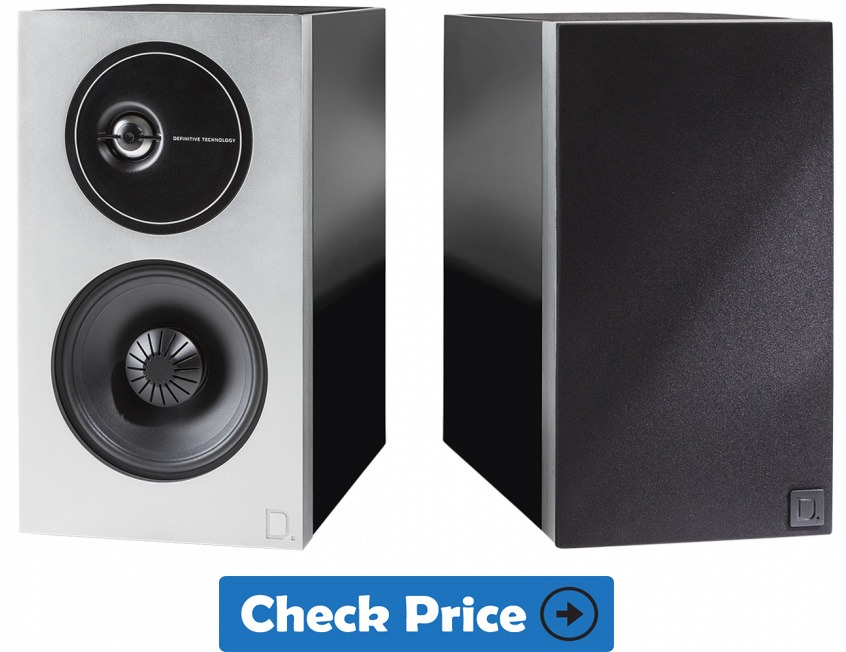 Intermediate model the new Demand Series by Definitive Technology, the D9 is a stylish 2-way bookshelf speaker with active/passive operation scheme which highlights the technology - exclusive Definitive Technology- used in the speakers it incorporates.
Intermediate model the new Demand Series by Definitive Technology, the D9 is a stylish 2-way bookshelf speaker with active/passive operation scheme which highlights the technology - exclusive Definitive Technology- used in the speakers it incorporates.
Regarding the tweeter, a design equipped with an aluminum dome of 25 mm diameter is used, mounted in an off-centered manner to achieve a more precise central stereo image by eliminating unwanted symmetrical diffraction, present in the corners of the panel frontal.
the new "20/20 Wave Alignment Lens", which aligns and softens the high frequencies emitted outside the symmetry axis of the tweeter to improve dispersion and thus provide a rich and balanced listening experience throughout the room.
Also the "mid-woofer" of the D9 -equipped with a polypropylene cone of 139'7 mm in diameter- incorporates several exclusive technologies that make it unique, the most significant being an ingenious and elaborate double peripheral suspension (BDSS or "Balanced Double Surround" System ") that allows greater cone displacements and higher sound pressure levels keeping the distortion controlled.
Linear Response Waveguide Technology
The patented Linear Response Waveguide technology extends the frequency response in and out of axis and at the same time improves dispersion to provide a more natural midrange timbre and a more accurate sound image.
BDSS Medium Range Woofer
The mid-range woofer with patented double balanced surround sound system (BDSS) provides more travel and output resulting in a higher mid-range detail and deeper bass compared to other cones of similar size.
Specifications
| Amplifier Wattage | 20W-150W per channel |
| Impedance | 8Ω |
| Driver Sizes | 5.25" Full range, 1" Tweeter |
| Sensitivity | 88dB |
| Bluetooth |
- Each speaker offers an unrivaled ideal spot
- Three-dimensional sound image to enjoy the ultimate premium shelf sound experience
- Superior acoustics Light and malleable concentrated rigidity
4.Audioengine HD6: Best Bookshelf Speakers Audiophile
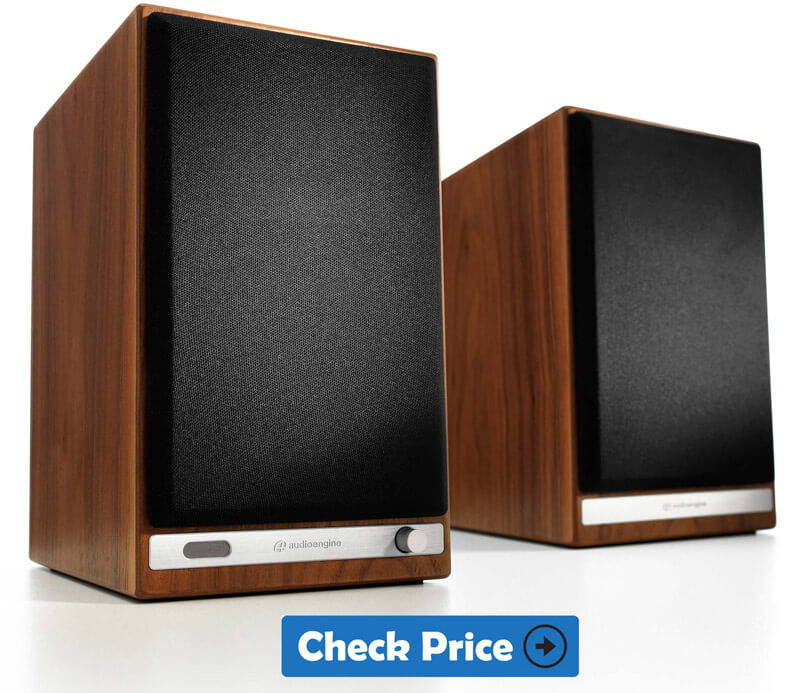 The active bookshelf speaker Audioengine HD6 is equipped with a 2x50 Watts RMS amplifier, and apt-X Bluetooth receiver as well as analog and digital inputs. The bass is clean, relatively deep with a touch of warmth while maintaining a certain lightness.
The active bookshelf speaker Audioengine HD6 is equipped with a 2x50 Watts RMS amplifier, and apt-X Bluetooth receiver as well as analog and digital inputs. The bass is clean, relatively deep with a touch of warmth while maintaining a certain lightness.
Bluetooth:
Its Bluetooth receiver allows streaming from any computer, smartphone or tablet. The three main audio transmission formats are supported: SBC (universal), AAC (Apple) and apt-X (high quality).
Remote control:
The Audioengine HD6 comes with a remote control, but also has, at the front on the left speaker, a rotary knob of volume and instantaneous mute by pressure. It is convenient.
Connectivity
An optical digital input allows the connection of any stereo source, including a TV. Stereo analog inputs in RCA format and mini-jack connect any analog source: CD player, smartphone, touchpad, video game console, TV, etc. A stereo RCA output is used to transmit the incoming stereo analog signal to a subwoofer,
Specifications
| Amplifier Wattage | - |
| Impedance | Ω |
| Driver Sizes | 5.5" Midrange, 1" Tweeter |
| Sensitivity | - |
| Bluetooth | Yes |
- A rich sound reproduction in details and in relief. An impressive sound presence for such small speakers. A grave very present in view of their size, without encroaching on the register of mediums.
- Complete connectivity by its 2 analog inputs, its 2 USB and Bluetooth digital inputs and its headphone output.
- Management of audio inputs without switch
5. Klipsch The Sixes: Best Wireless Bookshelf Speaker
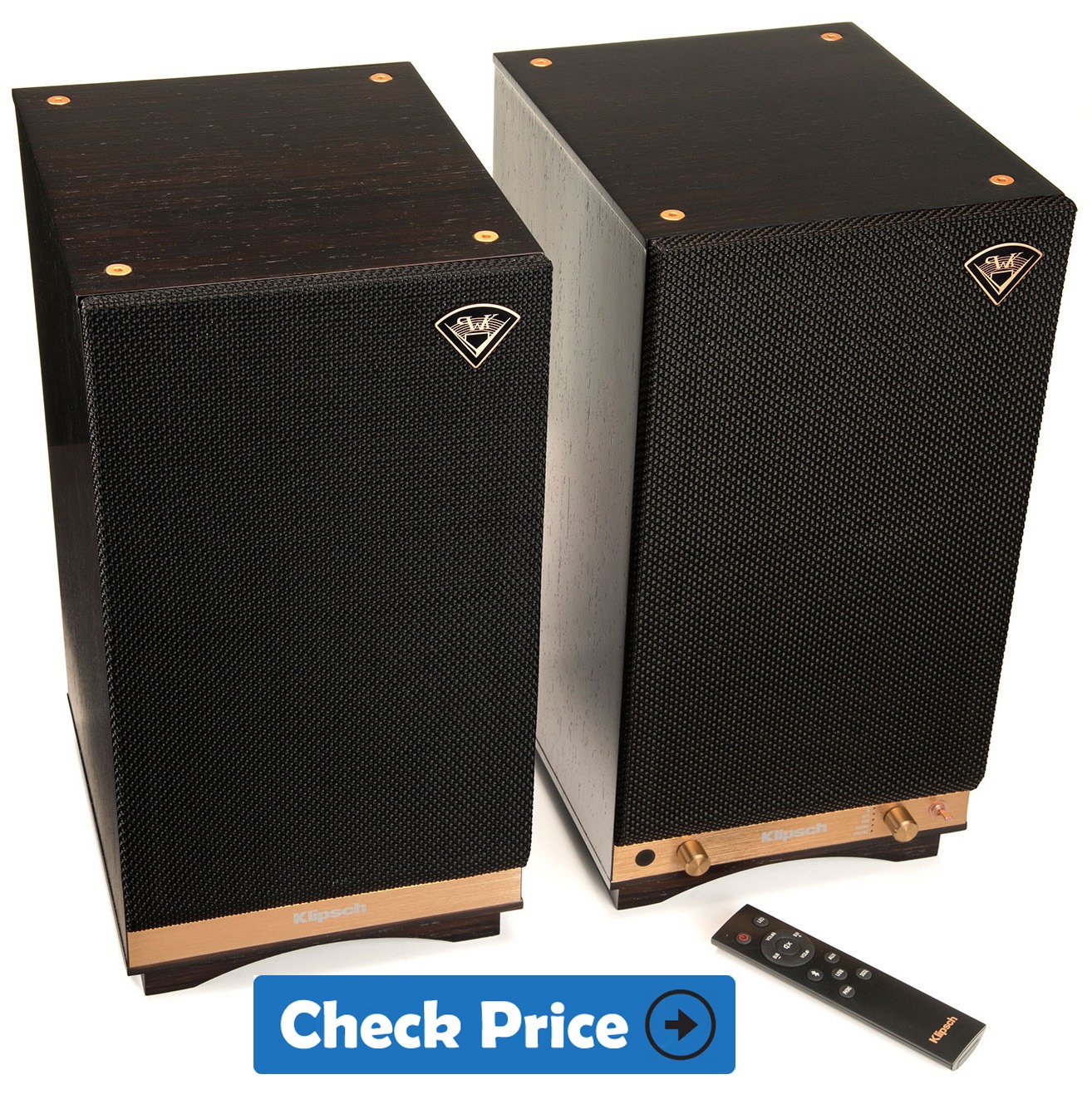 The Klipsch speakers are a good choice of stereo speaker option with an acceptable price. Its design is outstanding and they offer good sound, without fanfares.
The Klipsch speakers are a good choice of stereo speaker option with an acceptable price. Its design is outstanding and they offer good sound, without fanfares.
It is capable of delivering 100 W effective per channel, and up to 200 W peak, the right speaker also accommodates the stages of digital processing and pre-amplification.
Design:
The cabinetmaking, elegant, offers the Sixes a bass-reflex architecture. For this, the internal sound load is decompressed by a vent housed on their rear face. Carefully manufactured, it adopts an exponential mouthpiece to prevent the appearance of air noises during the most important movements of the boomer, especially on the deepest bass.
Bluetooth:
It is also used to make the pairing of Sixes with Bluetooth equipment: smartphone, tablet, walkman, etc. To do this, after selecting the Bluetooth input, simply hold it down for three seconds. The LED of the selector will then flash, indicating that the speakers are " visible " in the Bluetooth menu of the Smartphone. You have to select them on this one to validate the pairing; in short, a rather conventional procedure on this type of equipment.
Connectivity:
Its rear face is thus adorned with an optical input (96 kHz / 24 bits) which can, among other things, accommodate the sound of a TV, a USB-B input for the system can access the Hi-Res Audio files stored on a computer, and finally two analog inputs. If the first is equipped with a 3.5 mm mini-jack, specially dedicated to nomadic devices, the second on RCA is associated with a small slide switch that offers a dual-mode.
Remote Control:
Note that a small remote control doubles all of these functions. It is thus not essential that the Sixes are easily accessible to intervene both on the entry in use and on the volume of listening. Only the manipulation of the Phono / Line selector is a little less easy but, normally, this choice is determined during the setting up of the installation.
Specifications
| Amplifier Wattage | 100 W per channel |
| Impedance | Ω |
| Driver Sizes | 6.5" Midrange, 1" Tweeter |
| Sensitivity | 106dB |
| Bluetooth | Yes |
- It come with 1” titanium-loaded tweeters with tractrix horns
- produce room filing hifi sound
- eaily add a sub-woofer, if required
6. Q Acoustics 3020i
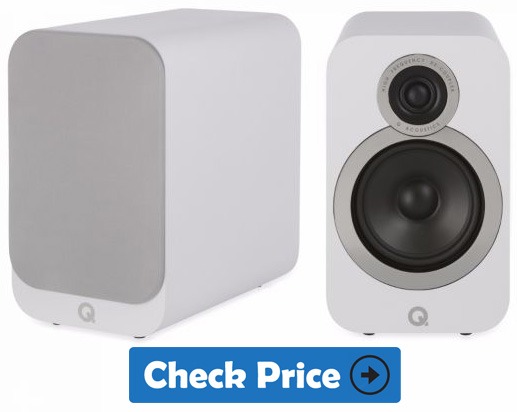 Some speakers are criticized for their open personality, for the exaggerated tonal characteristics that can distort the music. But it's hard to imagine someone taking Q Acoustics to the task for what they have forged with the 3020i bookshelf speakers.
Some speakers are criticized for their open personality, for the exaggerated tonal characteristics that can distort the music. But it's hard to imagine someone taking Q Acoustics to the task for what they have forged with the 3020i bookshelf speakers.
The special distinction of these speakers is a focus on sound optimization and unwavering clarity that serves almost all musical masters very well, from classical to folk, rock to hip-hop and jazz.
These speakers will send you running through your favorite recordings, so you can hear what nuances will be revealed. They stimulate studio performances with such presence, depth and rebound as to create a kind of sonic hologram that identifies the spatial location of the musicians in the mix, not only in the horizontal plane but also forward and backward, high and low.
Design
The distinctive feature of Concept 20 is its cabinet - inside a design cabinet. The enclosures are made of MDF (medium density fibreboard), a material valued for its neutral acoustic properties, but in this case, the cabinets have internal and external walls of MDF joined by a layer of adhesive that never solidifies.
Nicknamed the construction of Gelcore, Q Acoustics says that this design allows the kinetic energy produced by the controllers to be dispersed in the form of heat so that it does not color the audio reproduction of the speakers.
Performance
The 3020i is a great model in a full range of speakers from the 3000i series. You can mix and match them for multiple rooms, and multichannel home theater installations.
A pair of fabulous Q-Acoustics 3020i for music and TV/cinema presentations, especially in a small or medium room. Honestly, these bidirectional speakers with rear ports could easily pass to the floor standers.
On the cinematic front, I was swept with a precisely calibrated dialogue, dynamic sound effects in motion, and a solid score.
Specifications
| Amplifier Wattage | 15W-130W per channel |
| Impedance | 6Ω |
| Driver Sizes | 6.5" Midrange, 1" Tweeter |
| Sensitivity | 90dB |
| Bluetooth | No |
- Easily mount on wall
- Producing right tonally sound
- Zero negative reviews from customers
7.Fluance Signature Series Ai40 : Best HiFi Bookshelf Speakers
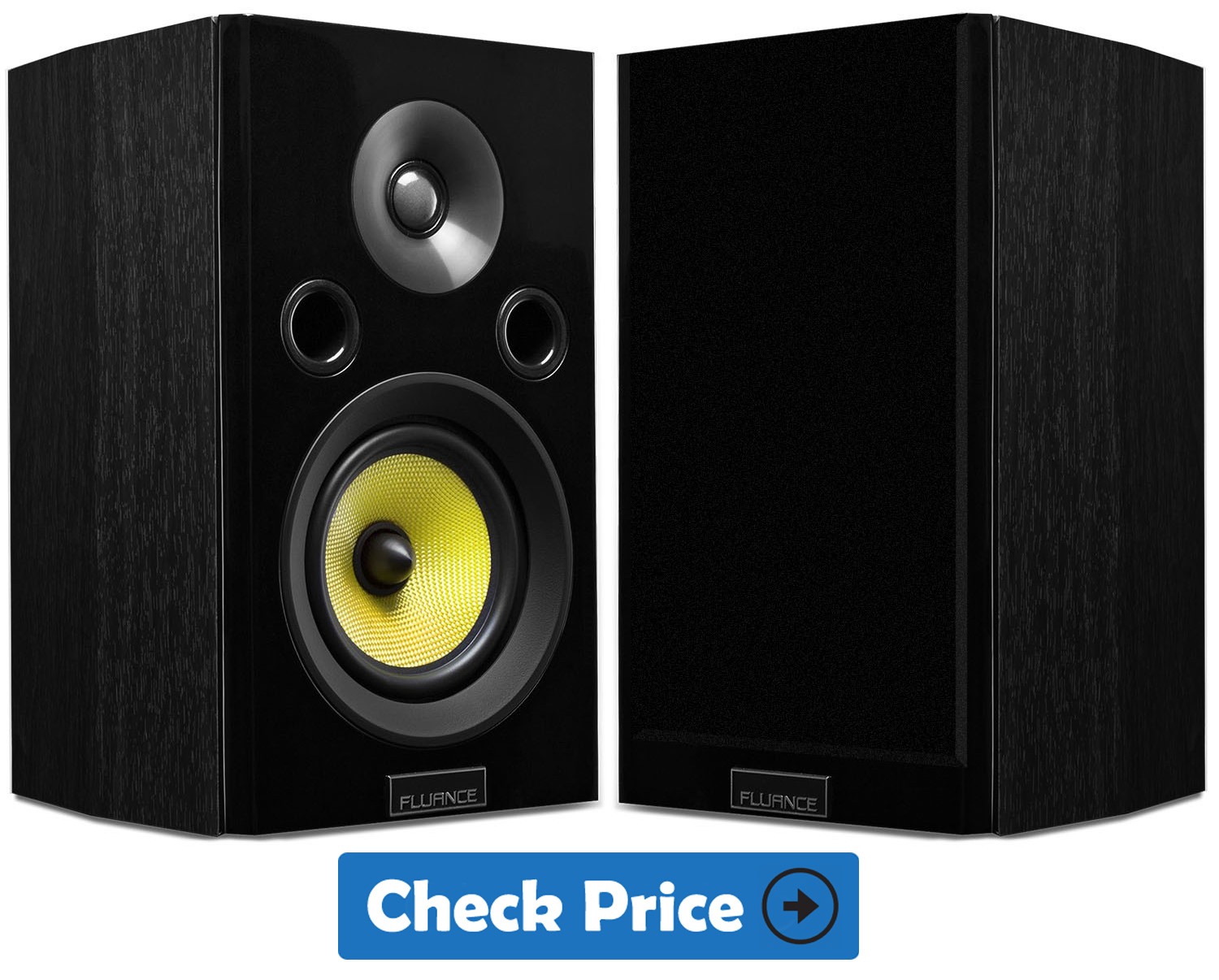 Its a compact loudspeaker in bookshelf speaker format with built-in amplifier and focused on users looking to mount a small high-fidelity system without too many complications or improve the sound of their televisions, PC, console, etc.
Its a compact loudspeaker in bookshelf speaker format with built-in amplifier and focused on users looking to mount a small high-fidelity system without too many complications or improve the sound of their televisions, PC, console, etc.
Design
It is the Ai40, built with medium density wood in a classic two-way configuration and using a 5-inch woofer accompanied by a silk dome tweeter with which you can reach a frequency response between 40 Hz and 20 KHz.
Drivers
The drivers are powered by two class D amplifiers with 35 watts per channel, which means a maximum of 70 watts RMS. To send the audio signal we can choose to use its Bluetooth interface compatible with aptX or directly by the classic stereo RCA analog cable.
Specifications
| Amplifier Wattage | 30W-120W per channel |
| Impedance | 8Ω |
| Driver Sizes | 5" Midrange, 1" Tweeter |
| Sensitivity | 85dB |
| Bluetooth | Yes |
- It a wall mountable comes with brackets
- Very Economical Price
8.Kanto YU6
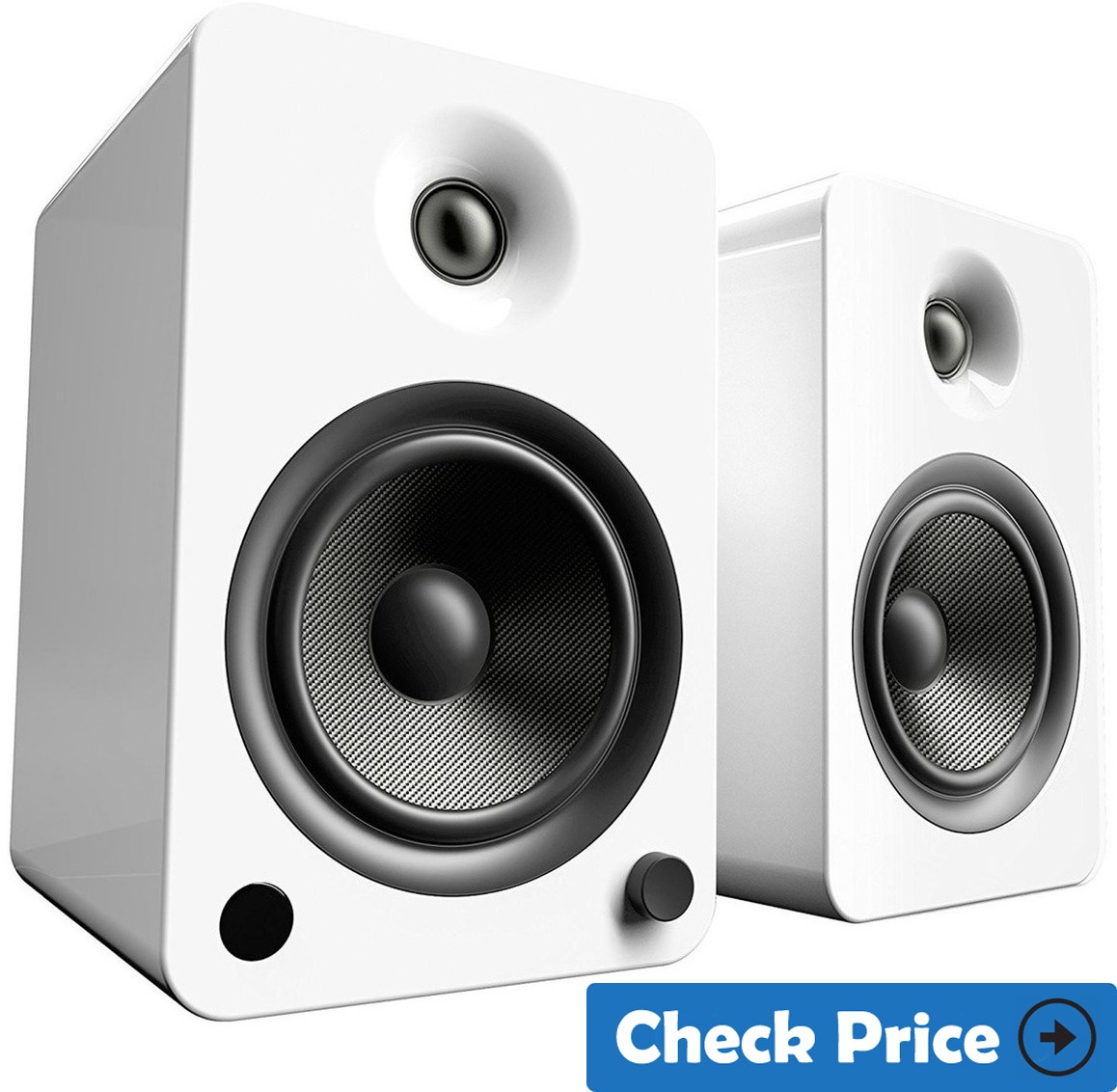 we can now find small speakers as powerful as big but can be put on a shelf or in a library.
we can now find small speakers as powerful as big but can be put on a shelf or in a library.
Design
Designed with carefully crafted cabinets, 1 "silk dome tweeters, and Kevlar drivers,
Performance
YU6 is the superior model of the YU series. It has a Class D amplifier that emits 200 W of maximum power. Its Kevlar 5.25 "drivers and 1" silk dome tweeters produce a detailed and powerful sound.
Bluetooth & Other Connectivity
Equipped with a range of inputs, the YU6 gives you the freedom to enjoy the sound of a variety of digital and analog devices. Its integrated phono preamp allows you to connect and rotate the music of your vintage or modern turntable so you can sit back and enjoy all your favorite vinyl records with the touch of a switch.
Your music via Bluetooth with your smartphone, a laptop or tablet, or Connect your non-Bluetooth devices through the AUX and RCA inputs and keep the music going all day and night with the convenient USB charging port. In addition, transmit high-quality sound from your TV through the TOSLINK digital input, or add some extra bass by connecting a subwoofer through the sub port.
Remote Control:
The Kanto YU6 also includes a remote control that controls everything from input selection, tone, volume, and playback, allowing you to control music from the comfort of your couch.
Specifications
| Amplifier Wattage | - |
| Impedance | Ω |
| Driver Sizes | 5.25" woofer, 1" Tweeter |
| Sensitivity | - |
| Bluetooth | Yes |
- It has automatic standby mode and power-on modes to save energy
- deep and powerful bass,well balanced and medium range performance and crystal clear and crisp
9. Wharfedale - Diamond 220 : Best Budget Bookshelf Speakers
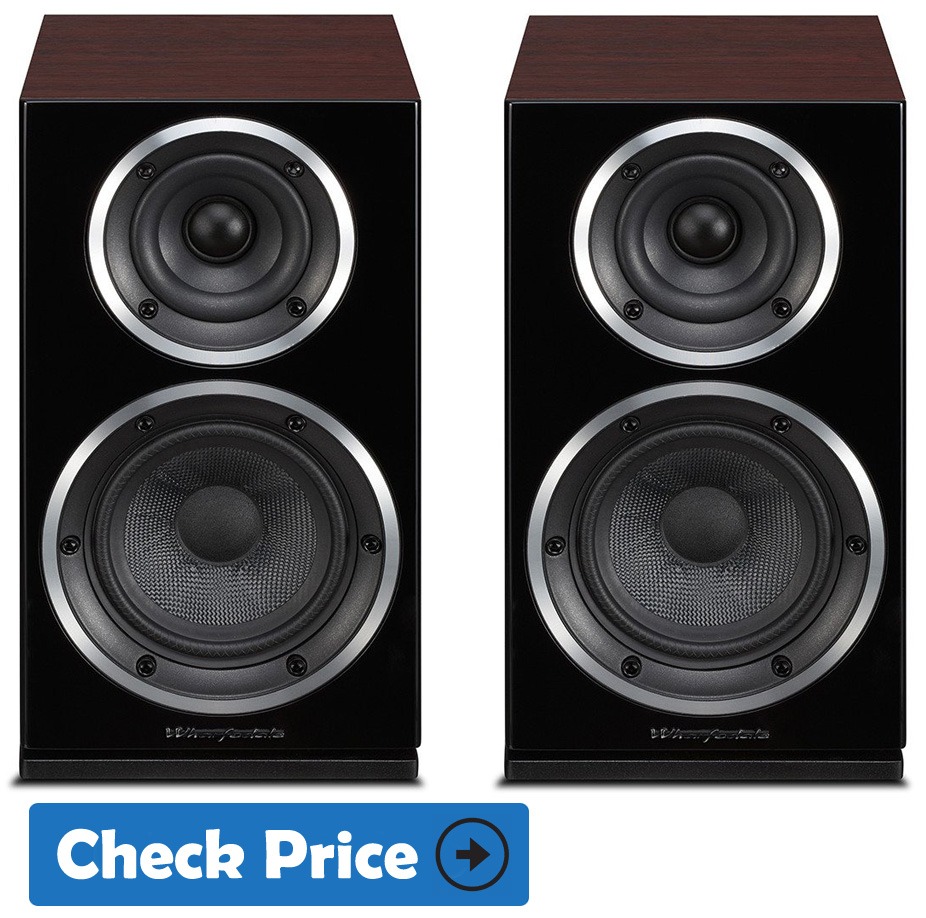 Simply put, the Wharfedale Diamond is one of the most successful speaker series in bookshelf speaker history, not to mention one of the most successful hi-fi speaker series ever seen and heard. We can justify it because, year after year, the Diamond series has broken the mold by offering a laureate quality of sound never heard for this price.
Simply put, the Wharfedale Diamond is one of the most successful speaker series in bookshelf speaker history, not to mention one of the most successful hi-fi speaker series ever seen and heard. We can justify it because, year after year, the Diamond series has broken the mold by offering a laureate quality of sound never heard for this price.
Design:
The front panel of the Audio Monitor has a very elegant aesthetic with that silver touch that is given to the tweeter. It's the first thing you'll call your sight.
It can be said that the vinyl finish is inevitable at this price, and it looks more elegant.
Specifications
| Amplifier Wattage | 25W-100W per channel |
| Impedance | 4Ω |
| Driver Sizes | 5.1" Full range, 1" Tweeter |
| Sensitivity | 87dB |
| Bluetooth | No |
- The sound behavior of remarkably good, high fidelity speakers
10. MartinLogan Motion 4i
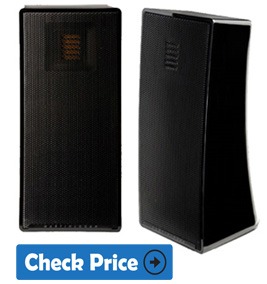 Motion 4 is a compact, very light and highly versatile monitor that combines a visually seductive and functionally useful aesthetic to configure stereo and multichannel sets capable of being easily integrated into prestigious spaces.
Motion 4 is a compact, very light and highly versatile monitor that combines a visually seductive and functionally useful aesthetic to configure stereo and multichannel sets capable of being easily integrated into prestigious spaces.
Ultra-compact 2-way bass-reflex speakers, Frequency divider filter executed with specially selected audiophile grade components.
Design:
It combines one of the exquisite Folded Motion folded diaphragm tweeters and a 104mm diameter "mid-woofer". The "mid-woofer" it is necessary to emphasize that it incorporates a diaphragm of treated paper and a steel chassis, at the same time that it is mounted in an asymmetric non-resonant chamber that allows minimizing the rupture modes.
Folding movement tweeter
The key to performance lies in the fast and bright response of the lightweight tweeter diaphragm, combined with a large surface (much larger than the typical one-inch dome tweeter) that together achieve a smooth and refined sound with a Impressive dynamic range and amazing clarity that drops the jaw-true to inspire envy in audiophiles and non-hearing aids alike.
Specifications
| Amplifier Wattage | 20W-150W per channel |
| Impedance | 4Ω |
| Driver Sizes | 4" Full range, 1 x 1.4" Tweeter |
| Sensitivity | 90dB |
| Bluetooth |
- Insightful sound
- Great versatility High Fidelity
- Decent pulsing drive
Things to Consider Before Buying The Best Bookshelf Speakers in 2025 | Buyer’s Guide
The Drivers are crucial for sound quality because they are the ones who have the role of converting electrical energy into sound waves.
Bookshelf speakers usually have two drivers:
- a woofer &
- a tweeter
The woofer provides the low end of the sound, usually around 40 to 1000 Hertz. Tweeter tuning with the high-end, sounds, up to about 20 kilohertz.
Some speakers are 3-way, which means they also have the midrange driver to meet the mediums. There are also full-range transducers that should provide low, medium and high sounds around by a driver - I would be cautious about buying a low-cost engine, however, as the sound quality is generally good.
Most novices and occasional buyers skip reading through all the technical specifications. But understand what the specifications for each model speaker can help you buy the right speakers for your needs.
Wired vs Wireless Speakers
Most people believe that the wireless Bluetooth speaker never sounds good as a wired speaker do, it’s a wrong perception. We have included both wireless and wired bookshelf speaker in our list.

Wired Bookshelf Speaker
Wireless Bookshelf Speaker
Klipsch the Sixes & Fluance Ai40 is a best wireless speaker and have a powerful and same sound as the wired speaker produce, it proves that the wireless speaker produces great bass if it’s streaming within its Bluetooth range.
Now a day the aptX is the leading and expensive Bluetooth technology and many speakers use it and capable of generating a sound you would love.
Other pros of having a wireless speaker are lack of mess. The wireless bookshelf speaker is not truly wireless, the frequently required a cable to connect the right and left the channel. Yes, they reduce the amount of cabling running through your Table/desk.
Another good of wireless speaker is you don’t need to plug the analog cable into them, it’s already equipped with Bluetooth or WIFI (sometimes both functionality available in one speaker) you can pair the devices without efforts. Our colleagues like to have wireless speaks in the office to switch between easily.
Passive vs Active Speakers
 Passive Speaker
Passive Speaker
The Bookshelf Speaker is usually passive it means that they need an external amplifier to powered it.
The HiFi component system/ receiver would normally comprise of your source of media player (DVD CD MP3 BluRay) connected to an amplifier which streams the speaker in stereo. If you want to connect your bookshelf speaker with Laptop/Desktop PC then you simply need a stereo amplifier to power your bookshelf speaker.
Active Speaker:
In case of the active speaker, it has a built-in power amplifier also call amps (one for the tweeter and one for the woofer) and you just need an audio feed (smartphone /tablet/PC)
If you are using A/V Receiver then normally RCA cable is used to connect directly to the powered speakers.
Now a day the best active bookshelf speaker is Audioengine HD6 just pick it and start enjoying music because you don’t need to match the amp here.
Impedance and Wattage: How to Match Amps and Speakers
This is a measure of the electrical resistance experienced by the speaker driver, normally 4, 6, or 16 ohms. Knowing the impedance can be useful for matching speakers with an amplifier, so the distortion can be minimized. bookshelf speakers should generally have an 8 ohm.
Another important specification deserves understanding, this specification tells you how much power a speaker can handle and is expressed in watts. See what you wanted out of the amplifier and try to match the speakers accordingly.
Sensitivity Explained
This affects how loud the speaker sounds at a given voltage and requires special attention when deciding on the suitability between an amplifier and the speakers. It is usually expressed in dB X for each XV input. The majority of people who buy bookshelf speakers use relatively small amplifier so will want higher decibel rank: at least 86 dB.
Frequency Response
This is basically the range of sounds that a speaker can produce. The best speakers, the best drivers offer two high and low ends of a piece of sound so natural audio. In general, if you buy a more expensive speaker, so try low accuracy, if you are looking at the end more accessible, then look for speakers with extended frequency response. The best speakers have a balance between high and low frequencies. Most library speakers are made with certain limitations, however, and are capable of reaching 45 to 20,000 Hz
Speaker Connections
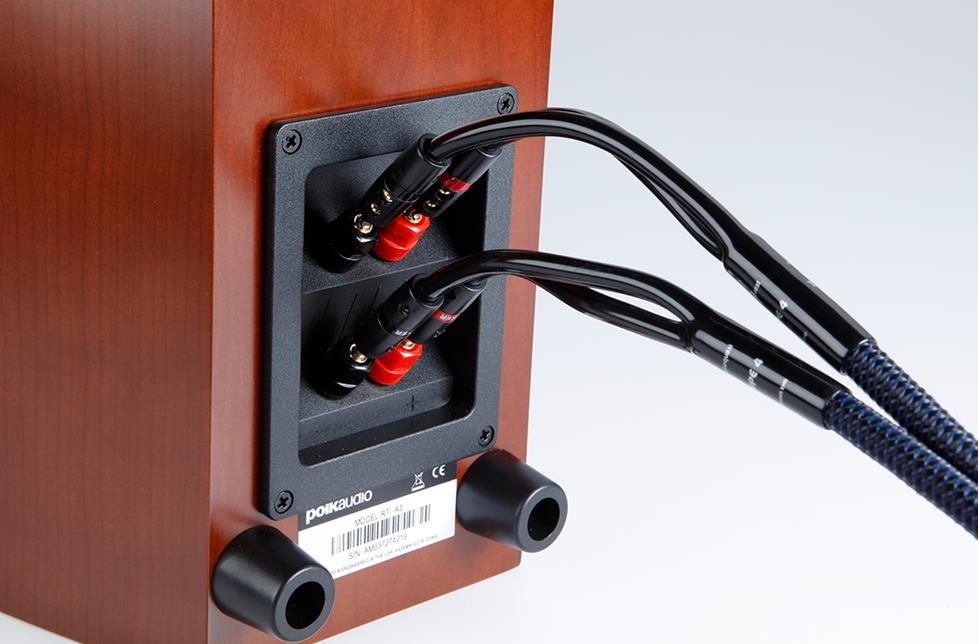 If you already have an amplifier (it’s a source of power & media such as Laptop/desktop PC or wireless streamer) then you have to look for speaker’s wires (Red and Black rotaries) to connect with the amp. Sometimes, they will take the form of tiny squares you can pull-out wires into labeled plus/minus.
If you already have an amplifier (it’s a source of power & media such as Laptop/desktop PC or wireless streamer) then you have to look for speaker’s wires (Red and Black rotaries) to connect with the amp. Sometimes, they will take the form of tiny squares you can pull-out wires into labeled plus/minus.
- Buy 16 gauge cheap speaker wire perfect for 4 to 8 ohms. Cut off the wire according to your requirement and area by using a box cutter to strip the insulation off on both ends
- Now insert the wire into the binding posts on both ends by separating speakers to the right and the left.
- Make sure that the wires are screw black into the black, red into the red
Bookshelf Speakers vs 2.1 Sound Setup
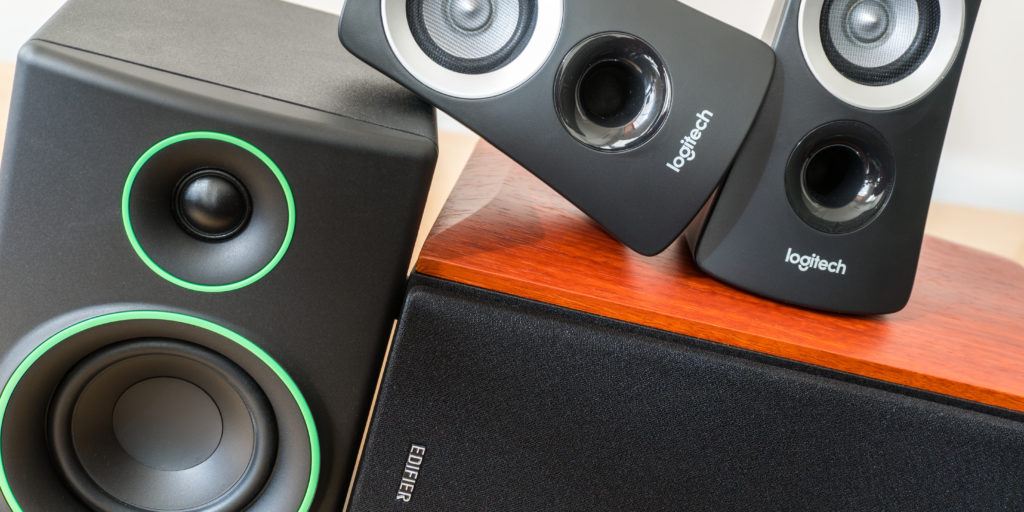 Bookshelf speaker is renowned for its smooth sound and very rational to the music content and audio recordings. They are small to medium in size and be able to certain bass frequencies.
Bookshelf speaker is renowned for its smooth sound and very rational to the music content and audio recordings. They are small to medium in size and be able to certain bass frequencies.
If you add a subwoofer to bookshelf speaker it becomes a 2.1 system and produces very remarkable sound because the mid & upper frequency is supported by a fully prolonged low bass.
Bookshelf Speakers as a Surround Sound
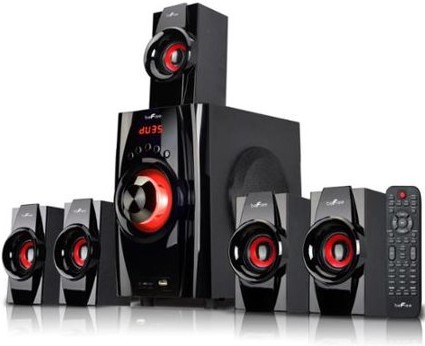 If you want to convert your bookshelf speaker into 5.1 or 7.1 surround sound setup, of course, you can, but you would need the AV receiver with perfectly sufficient power to match your speakers.
If you want to convert your bookshelf speaker into 5.1 or 7.1 surround sound setup, of course, you can, but you would need the AV receiver with perfectly sufficient power to match your speakers.
Each speaker essentials to connect to its own power channel (red to red & black to black). Kindly noted here; that the bookshelf speaker is sold in pairs, if you want to make a classic 5.1 surround setup then you have to buy the 3 pairs and one subwoofer and leave one speaker as a decoration.
You can use the bookshelf speaker as front left and right.
Bookshelf Speaker Placement Explained
When using the Bookshelf speaker indoors, the tonal quality may vary depending on where you place the speaker in a room. When you move the speaker inside a room or change it from one room to another, keep the following guidelines in mind:
- The speaker is designed to have a better sound when it is placed on a shelf, countertop, desk, table or mount on the wall.
- To obtain a better bass response, the speaker should be placed close to a wall; the bass response decreases as the speaker is placed closer to the center of a room.
- When you operate the loudspeaker, always use the cover as support.
- Do not place the speaker lying on its back. The sound is emitted from the front and back of the unit You should not place the speaker in small areas that are surrounded on all sides except the front, as this will adversely affect the sound quality.
- Do not place the speaker on wet or unclean surfaces. If you do, you could transfer dirt, sand or moisture to the speaker when the cover is closed
Speaker Stands
Setup and Placement Tips
- Positioning: Place your speakers on stands at an equal distance from each other and the wall for balanced sound. Aim to form an equilateral triangle with your listening position for the best stereo imaging.
- Surface Stability: Ensure the stands are on a flat, stable surface to prevent any wobbling or movement.
- Toe-In: Slightly angle the speakers towards your listening position for improved soundstage and clarity.
Best Bookshelf Speakers FAQs
- Can bookshelf speakers be used as studio monitors?
Absolutely, you can use bookshelf speakers as studio monitors. They can provide a good level of accuracy for mixing and sound production, especially if they have a flat frequency response. - Can bookshelf speakers work with a desktop PC/laptop without an amplifier?
It depends on the type of bookshelf speakers you have. Passive bookshelf speakers require an amplifier to function, while active (powered) bookshelf speakers have a built-in amplifier and can be directly connected to a desktop PC or laptop. - How to enable the Bluetooth of bookshelf speakers?
To enable Bluetooth on bookshelf speakers, ensure the speakers have Bluetooth capability. Turn on the speakers and activate Bluetooth mode, typically by pressing a dedicated button or using the remote control. Then, pair them with your device by selecting them from the Bluetooth settings. - Can I attach a subwoofer to bookshelf speakers?
Yes, it is very simple to add a subwoofer to bookshelf speakers because the subwoofer is self-powered and doesn’t need separate amplification. Connect the subwoofer wire into the audio output of the receiver. If you are not using an amplifier or are just using a stereo power amp, the approach will be different. Subwoofers come with audio inputs and outputs, so you need to plug your source into the subwoofer and then feed the audio outs from the sub into your amp’s input. - Difference between floor standing and bookshelf speakers?
Floor-standing speakers are larger and typically provide more powerful bass response and overall sound volume compared to bookshelf speakers. They are designed to stand on the floor and often have multiple drivers for better sound dispersion. Bookshelf speakers, on the other hand, are smaller and designed to fit on shelves or stands, making them more versatile for smaller spaces. - What kind of receiver do I need to hook up a pair of 4-8 ohm bookshelf speakers?
You will need a receiver that is compatible with the impedance of your speakers (4-8 ohms). Most modern AV receivers support a wide range of speaker impedances, so a standard stereo or home theater receiver should work well. Ensure the receiver has enough power output to match your speakers' requirements for optimal performance. - What is the optimum crossover frequency for bookshelf speakers?
The optimum crossover frequency for bookshelf speakers typically ranges from 60Hz to 80Hz. This allows the speakers to focus on mid and high frequencies while sending lower frequencies to the subwoofer, enhancing overall sound quality. However, the exact frequency may vary based on the specific speakers and subwoofer used, so it’s a good idea to experiment with different settings for the best results.
Conclusion
Choosing the right speaker stands can significantly enhance your audio experience. Take the time to consider height, stability, aesthetics, and compatibility with your bookshelf speakers. By following these guidelines, you can create an effective and visually appealing audio setup that maximizes sound quality and performance.





